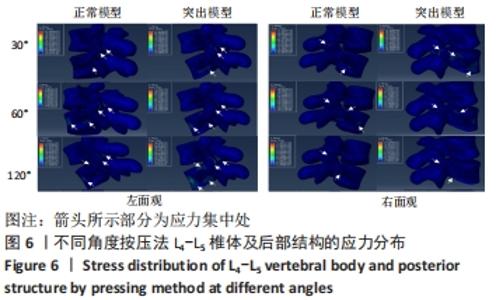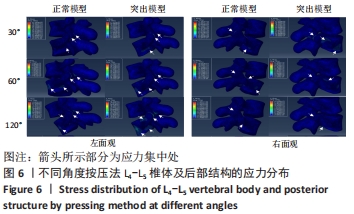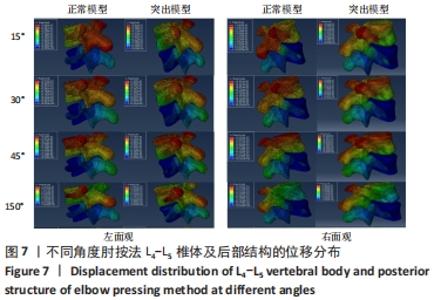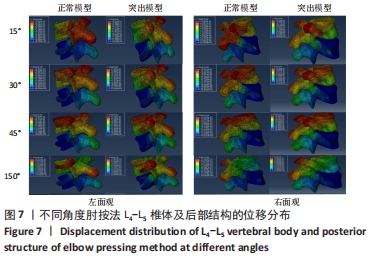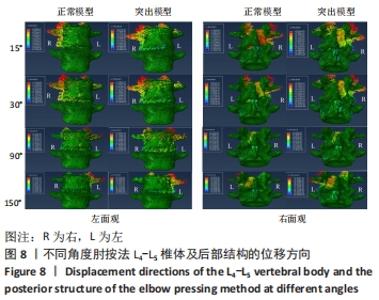[1] AMIN RAJ M, ANDRADE NICHOLAS S, NEUMAN BRIAN J. Lumbar Disc Herniation.Curr Rev Musculoskelet Med. 2017;10(4):507-516.
[2] Benzakour T, Igoumenou V, Mavrogenis AF, et al. Current concepts for lumbar disc herniation. Int Orthop.Int Orthop. 2019;43(4):841-851.
[3] 于海江,祝斌,刘晓光. 青少年腰椎间盘突出症的研究进展[J]. 中国微创外科杂志,2021,21(1):73-76.
[4] 郭锐伟.不同作用时间肘按法对慢性腰肌劳损疼痛改善的对比研究[D].广州:广州中医药大学,2018.
[5] 陈永智,杨晓峰,孔力. 肘部重力按摩治疗老年腰椎间盘突出症(缓解期)的疗效[J].中国老年学杂志,2014,34(3):824-825.
[6] 林志刚,王建珠,宋朋飞,等. 推拿按揉法对腰椎间盘突出症大鼠脊髓背角NK1R及场电位的影响[J]. 时珍国医国药,2020,31(1):253-256.
[7] PANAGIOTACOPULOS ND, POPE MH, KRAG MH, et al. Water content in humanintervertebral discs. Part I. Measurement by magnetic resonance imaging.Spine. 1987;12(9):912-917.
[8] 冯勇,刘道志.不同腰椎融合器对邻近节段影响的生物力学研究[J].中国生物医学工程学报,2010,29(5):717-723.
[9] LIPSCOMB KE, SARIGUL-KLIJN N, KLINEBERG E,et al. Biomechanical Effects of Human Lumbar Discography: In Vitro Experiments and Their Finite Element Validation. Clin Spine Surg. 2017;30(3):E219-E225.
[10] 徐浩,张秋林,唐昊,等.腰椎 L3-L5 三维有限元模型的有效性验证[J].中国组织工程研究,2013,17(35):6261-6266.
[11] ZHANG R, MO Z, LI D, et al. Biomechanical Comparison of Lumbar Fixed-Point Oblique Pulling Manipulation and Traditional Oblique Pulling Manipulation in Treating Lumbar Intervertebral Disk Protrusion. J Manipulative Physiol Ther. 2020;43(5):446-456.
[12] 方新果,赵改平,王晨曦,等.基于CT图像腰椎L4~L5节段有限元模型建立与分析[J].中国物医学工程学报,2014,33(04):487-492.
[13] PINTAR FA, YOGANANDAN N, MYERS T, et al. Biomechanical properties of human lumbar spine ligaments.J Biomech. 1992;25(11):1351-1356.
[14] GILBERTSON LG, GOEL VK, KONG WZ, et al. Finite element methods in spine biomechanics research. Crit Rev Biomed Eng. 1995;23(5-6):411-473.
[15] FAIZAN A, SAIRYO K, GOEL VK, et al. Biomechanical rationale of ossification of the secondary ossification center on apophyseal bony rin g fracture: a biomechanical study. Clin Biomech (Bristol, Avon). 2007;22(10):1063-1067.
[16] SHARMA M, LANGRANA NA, RODRIGUEZ J. Role of ligaments and facets in lumbar spinal stability. Spine. 1995;20(8):887-900.
[17] CHEN SH, ZHONG ZC, CHEN CS, et al. Biomechanical comparison between lumbar disc arthroplasty and fusion. Med Eng Phys. 2009;31(2):244-253.
[18] POLIKEIT A, FERGUSON SJ, NOLTE LP, et al. Factors influencing stresses in the lumbar spine after the insertion of intervertebral cages:finite element analysis. Eur Spine J. 2003;12(4):413-420.
[19] 苏晋,赵文志,陈秉智,等.建立全腰椎有限元接触模型[J].医用生物力学, 2010,25(3):200-205.
[20] 黄菊英,李海云,吴浩.LDH力学特征的仿真计算方法[J].医用生物力学,2012, 27(1):96-101.
[21] 赵亮,闫广华,瞿东滨,等.腰椎间盘退变对软骨终板生物力学特性影响的有限元分析[J].中国临床解剖学杂志,2015,33(4):455-460.
[22] LI L, SHEN T, LI YK. A Finite Element Analysis of Stress Distribution and Disk Displacement in Response to Lumbar Rotation Manipulation in the Sitting and Side-Lying Positions. J Manipulative Physiol Ther. 2017;40(8):580-586.
[23] 颜文涛,赵改平,方新果,等.人体腰椎L(4~5)节段有限元建模及分析[J].生物医学工程学杂志,2014,31(3):612-618.
[24] 王宏卫,刘新宇,万熠.人体腰椎L4~L5段有限元模型建立及力学有效性验证[J].医学与哲学(B),2017,38(5):50-53.
[25] XU M, YANG J, LIEBERMAN I, et al. Finite element method-based study for effect of adult degenerative scoliosis on the spinal vibration characteristics.Comput Biol Med. 2017;84:53-58.
[26] Henao J, Aubin CÉ, Labelle H, et al. Patient-specific finite element model of the spine and spinal cord to assess the neurological impact of scoliosis correction: preliminary application on two cases with and without intraoperative neurological complications.Comput Methods Biomech Biomed Engin. 2016;19(8):901-910.
[27] Mengoni M. Using inverse finite element analysis to identify spinal tissue behaviour in situ. Methods. 2021;185:105-109.
[28] 陶勇,吴云乐,宗少晖,等.基于有限元分析腰椎内固定的生物力学特征[J].中国组织工程研究,2016,20(13):1932-1938.
[29] 王宇,雷建银,辛浩,等.椎间盘退变颈椎(C2-C7)在正常承载与推拿下的有限元分析[J].中国组织工程研究,2020,24(27):4278-4284.
[30] 田强,钟侨霖,赵家友,等.提拉旋转斜扳法操作时腰椎椎间盘应力及应变的有限元研究[J].中国临床解剖学杂志,2019,37(1):83-86.
[31] 黄法森. 清宫正骨弯腰挺立手法治疗腰骶关节紊乱的有限元分析[D].北京:中国中医科学院,2018.
[32] ASANO S, KANEDA K, UMEHARA S, et al. The mechanical properties of the human L4–5 functional spinal unit during cyclic loading: the structural effects of the posterior elements. Spine.1992;17(11):1343-1352.
[33] Schroeder GD, Guyre CA, Vaccaro AR. The epidemiology and pathophysiology of lumbar disc herniations. Semin Spine Surg. 2016;28(1):2-7.
[34] ZHAO P, FENG TY. The biomechanical significance of herniated lumbar intervertebral disk: a clinical comparison analysis of 22 multiple and 39 single segments in patients with lumbar intervertebral disk herniation. J Manipulative Physiol Ther. 1996;19(6):391-397.
[35] 黄学成,叶林强,伍子贤,等.基于“筋出槽、骨错缝”理论探讨神经根型颈椎病的CT特征[J].中华中医药杂志,2019,34(8):3483-3487.
[36] 户小彬,张涛,王欣.腰椎关节突三维角度与单节段同水平腰椎间盘突出相关性研究[J].天津医科大学学报,2020,26(5):454-456+470.
[37] 丁金勇,徐继禧,谭成双,等.不同关节突关节不对称衡量标准的有限元评价[J].山东大学学报(医学版),2020,58(6):97-103.
[38] 任东成,丁金勇,徐继禧,等.青少年腰椎间盘突出症患者下腰椎关节突关节不对称情况分析[J].中国脊柱脊髓杂志,2019,29(5):437-443.
[39] 李俊毅,孔赏,马虎升,等.手法治疗腰椎间盘突出症的作用机制研究进展[J].中医正骨,2019,31(4):40-42.
[40] 龚成,谢瑛,郭伟,等.脊柱定点旋转复位手法治疗对613例腰椎间盘突出症患者腰椎活动度及活动度对称性的影响[J].中华中医药杂志,2021,36(1): 599-601.
[41] 杨舟,艾坤,于隽,等.浅谈点按法的临床应用现状[J].中华中医药杂志, 2015,30(6):2026-2028.
[42] 叶宜颖,高景华,高春雨.有限元分析法在脊柱推拿手法生物力学研究中的应用[J].中医正骨,2016,28(10):29-31,37.
|
